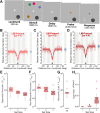Independent working memory resources for egocentric and allocentric spatial information
- PMID: 30789899
- PMCID: PMC6400418
- DOI: 10.1371/journal.pcbi.1006563
Independent working memory resources for egocentric and allocentric spatial information
Abstract
Visuospatial working memory enables us to maintain access to visual information for processing even when a stimulus is no longer present, due to occlusion, our own movements, or transience of the stimulus. Here we show that, when localizing remembered stimuli, the precision of spatial recall does not rely solely on memory for individual stimuli, but additionally depends on the relative distances between stimuli and visual landmarks in the surroundings. Across three separate experiments, we consistently observed a spatially selective improvement in the precision of recall for items located near a persistent landmark. While the results did not require that the landmark be visible throughout the memory delay period, it was essential that it was visible both during encoding and response. We present a simple model that can accurately capture human performance by considering relative (allocentric) spatial information as an independent localization estimate which degrades with distance and is optimally integrated with egocentric spatial information. Critically, allocentric information was encoded without cost to egocentric estimation, demonstrating independent storage of the two sources of information. Finally, when egocentric and allocentric estimates were put in conflict, the model successfully predicted the resulting localization errors. We suggest that the relative distance between stimuli represents an additional, independent spatial cue for memory recall. This cue information is likely to be critical for spatial localization in natural settings which contain an abundance of visual landmarks.
Conflict of interest statement
The authors have declared that no competing interests exist.
Figures




References
Publication types
MeSH terms
Grants and funding
LinkOut - more resources
Full Text Sources
Molecular Biology Databases

